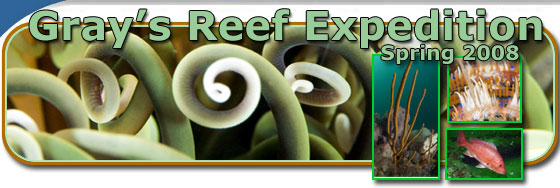Error processing SSI file
|
Mission Log: May 15, 2008
NOAA Ship Nancy Foster
By Kathryn Kornberg, Beth McGovern and Steve Desper
Wow! It was another productive day on the Nancy Foster. Throughout the day work continued on the many projects that have been undertaken this week.
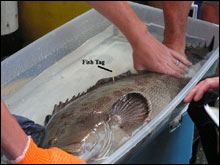 |
|
Scamp grouper being tagged.
|
The scamp grouper in which tags were placed yesterday were doing well this morning, and the NOAA divers, Laurie, Marc, and Matt accompanied by Scott, prepared for releasing the fish by placing one of the sonic receivers in the sanctuary. The receiver was suspended from an underwater surface buoy, and a 75 pound weight was attached to ensure that the receiver remains in place. The receiver will internally record data on fish movement. Scientists will periodically retrieve the data. While diving, Laurie, Marc, Matt, and Scott were also able to remove some debris from the sanctuary and bring it back to the Foster to be sorted and evaluated.
After the divers returned from successfully placing the receiver, everyone was looking forward to lunch, as one of the highlights of life aboard the Nancy Foster would have to be the food. The Foster is blessed with two excellent cooks, Dennis Moore and Angelito Llena, both retired Navy, who keep the ship’s crew and the scientists well-fed. Dennis has been with NOAA for 26 years. Angelito has been with NOAA for 5 years. Breakfast is served short-order style, and may include eggs to order, waffles, pancakes, French toast, pastries, hash browns, bacon and sausage. The lunch menu usually includes at least two different entrees, side dishes, salad bar and homemade desert. Personally, I recommend the bacon cheeseburger and the peach cobbler!
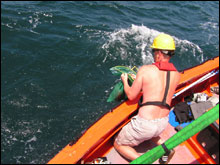 |
|
Matt lowers tagged fish into water.
|
Following our delicious lunch everyone went back to work. The Foster returned to the GPS coordinates where the three scamp were caught yesterday. In preparation for release, one of the launches was suspended off the starboard side of the ship, creating a platform from which the fish could be lowered into the water. Beginning with the smallest fish, Marc and Greg netted each fish and transferred it to Matt, waiting in the launch. Matt immediately lowered the net into the water enabling the fish to swim freely out of the net. This process was then repeated with the other two fish.
The Georgia Southern divers, Danny, Kenan, and Lauren, accompanied by Greg, continued evaluation of invertebrate populations. Lots of animals on Earth have backbones, including people, but not nearly as many as those who don’t. Approximately 95% of all animals on the Earth are invertebrates, or animals without backbones. Invertebrates live everywhere – in your house, in your yard, and in the sea. Invertebrates in the ocean come in a wide variety of shapes, sizes, colors. In fact, each day may reveal a new species that has not been discovered or studied yet.
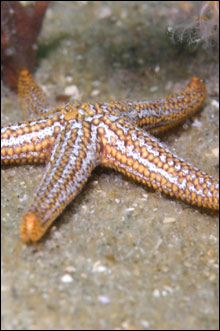 |
|
Seastar which is common in the waters off Southeast Georgia
|
In addition to describing the invertebrates that live on and around Gray’s Reef, Danny, Kenan, and Lauren are continuing work on designing experiments to determine how these invertebrate communities change over time. Each day, they load their SCUBA gear aboard one of the RV Nancy Foster’s small boats and take off to locations on the Reef they may want to study. Once a suitable location on the Reef is found, they will randomly choose an area, usually a ledge on the reef, to be their study location. They use a 0.5 meter by 0.5 meter square, or quadrat, made from PVC pipe and string creating a grid. The quadrats are placed on the sea floor, and the scientists count the number of squares covered by each species. Using this method, they can estimate the percent coverage of each species of invertebrate. It is very important to be able to identify many species of invertebrates in order to properly conduct studies using the quadrats.
Another project they are conducting at Gray’s Reef deals with permanently placed plots. The small plots will be placed at the bottom of the reef in various locations and monitored to see what kind of species colonize and survive there. When the plots are originally placed, all the invertebrates that live there will be cleared and scraped away. They will be followed and photographed to see what invertebrates come to colonize and how long they survive in these areas. By seeing what comes back and how long it takes for these species to establish themselves, the scientists can gather data on recruitment, growth and death rates. An equal number of plots will be left unchanged to act the control. Danny has been monitoring a similar study at J-Reef since 2004.
Today the Georgia Southern divers surveyed multiple plots and found that many areas that once contained live bottom have now been covered with sand. The group was scheduled to conduct a second afternoon dive, but mother nature and her growing swells dictated that we “mow the lawn” (multibeam) instead. Data collection for the invertebrate project will continue as soon as the weather allows for safe diving again.
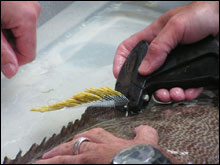 |
|
Greg inserts spaghetti tag.
|
During the afternoon dives, Jimmy and Kathryn joined NOAA staff members and members of the Georgia Department of Natural Resources Coastal Resources Division on the R/V Joe Ferguson to capture more grouper and snapper for tagging via hook and line sampling. Another scamp grouper was caught and delivered to the Nancy Foster. Later in the afternoon Greg, Marc, and Matt performed the surgical procedure to tag the fish and plan to release it tomorrow.
After diving this morning, Cathy Sakas departed the ship, returning to Skidaway Island on the Joe Ferguson, and Laurie Brokaw, an educator with the Buncombe County Soil and Water Conservation District in Asheville, NC joined us on the Foster. Currently wave height is increasing and wave period is decreasing making for a very bumpy ride. As we conclude the day we await changes in the weather to determine the plan for tomorrow.
|

